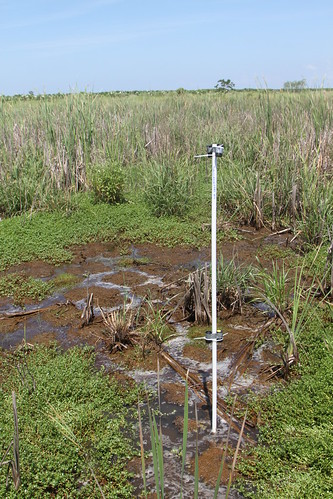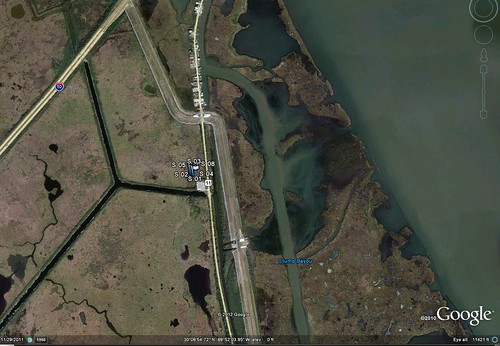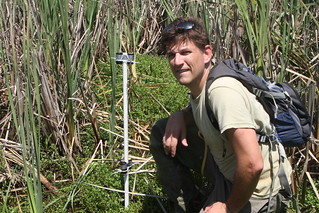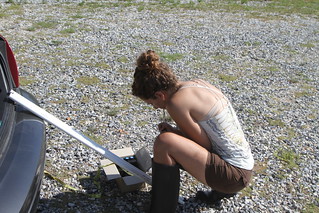Today, Shannon and Scott placed 4 x 8 = 32 H2S test strips in a degraded wetland under pump in Orleans Parish, LA.
We attempted to deploy a balloon, but it popped and with it went our onsite Helium supply.
4 of the 8 pvc staffs were short (~4'), and 4 tall (~6'), to get a range of distances from the ground. Because the ground all around is the source, the circular pattern was scrapped for now.
Within each canister pair, different types of openings were made. These will be described in an addendum. There was a single nail-hole canister within every pair. some pairs had their caps removed, with a small piece of ducttape to prevent the test strip from falling out; other pairs had three nail holes punched in their caps.
Scott will make a return visit during the week. Retrieval will begin at S 08, as the holes were made starting at S 08, and after 15 minutes, holes were completed in S 01.
Retrieval will include taping over the holes tightly (or replacement of caps) with black Gaffe tape, placement in box for mailing to their destination.
Video forthcoming.
GPX here: http://db.tt/OFijxucU
more photos here https://www.flickr.com/photos/eustatic/tags/h2s/
Large detail of holes here https://farm9.staticflickr.com/8017/7428649544_35409a79b1_h.jpg
 Taller staff (S05 - S08) are 21" and 56" above the surface
Taller staff (S05 - S08) are 21" and 56" above the surface
 G Earth shot showing GPS locations, NW of parking lot. Pump is SE of parking lot. Natural wetlands are to the right of the levee. Note the difference in color. There is a large species difference.
G Earth shot showing GPS locations, NW of parking lot. Pump is SE of parking lot. Natural wetlands are to the right of the levee. Note the difference in color. There is a large species difference.
 crouched next to short staff (S01- S04; 11" and 33" above the surface)
crouched next to short staff (S01- S04; 11" and 33" above the surface)
 Shannon labelling and building
Shannon labelling and building
 stilts gonna getcha
stilts gonna getcha




7 Comments
Video here, after a day or so https://vimeo.com/44587971
weather station is here: http://www.wunderground.com/weatherstation/WXDailyHistory.asp?ID=KLASLIDE15&day=23&month=06&year=2012
Although I think the wind was blowing to the west...
Is this a question? Click here to post it to the Questions page.
Reply to this comment...
Log in to comment
Too bad about the balloon, but more importantly it's great to see progress on this front! Nice work.
Reply to this comment...
Log in to comment
photos of the bayou rebirth replanting of this site in 2009. neither Spartina nor Scirpus took, but Typha recolonized? this area. or were planted.
https://www.flickr.com/photos/eustatic/3453959944/in/photostream/
https://www.flickr.com/photos/eustatic/3505431964/
https://www.flickr.com/photos/eustatic/3505432080/
Is this a question? Click here to post it to the Questions page.
Reply to this comment...
Log in to comment
I am interested in repeating this H2S measuring procedure with some modifications. Hydrothermal vents have been suggested as point sources, but I've noticed that this experiment takes place in a marsh. I'm assuming from my reading that this experiment is measuring H2S produced by anaerobic degradation of plant material by bacteria. What is a good set of criteria for identifying a wetland that will produce high amounts of H2S? Can you point me to any papers on this subject? I live in the San Francisco bay area, so there may be many opportunities if brackish marshes can exhibit this behavior.
Is this a question? Click here to post it to the Questions page.
Reply to this comment...
Log in to comment
copying my mailing list comment back in here:
Is this a question? Click here to post it to the Questions page.
Reply to this comment...
Log in to comment
Jeff, would be excited about a sensor.
I don't think wetlands get above 5ppm...
but eventually we want to target Murphy refinery down the way, so...this sensor would be useful!!
Reply to this comment...
Log in to comment
I volunteer some of my time to help nonprofits with their websites. I worked in IT for 23 years and was a professional webmaster too. I've helped eight organizations so far. Do you have any interest in getting a new website for free? I just helped an animal shelter and their site is really nice now. I helped a women's center before that.
Sincerely, Jessica Graham
Is this a question? Click here to post it to the Questions page.
Reply to this comment...
Log in to comment
Login to comment.